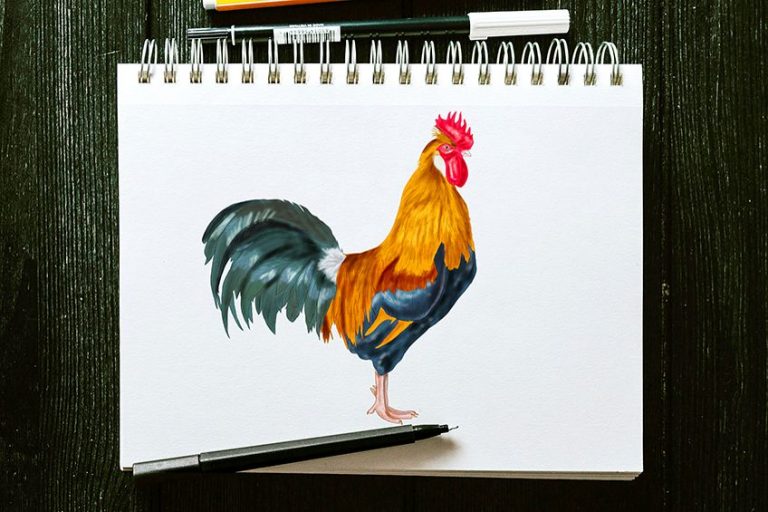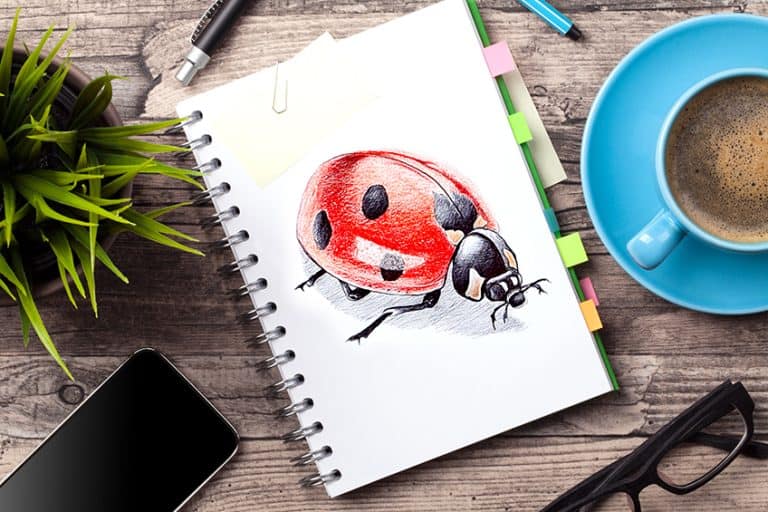How to Draw a Guinea Pig – Pet Rodent Drawing Lesson
Have you ever wanted to know how to draw a guinea pig? If the answer is yes, then you have come to the right place! Whether you have had a pet guinea pig or not, you cannot deny their sweet charm. These furry creatures are very friendly and full of life. They also make fantastic subjects to draw. In this easy-to-follow drawing tutorial, we show you how to construct, detail, and color a realistic guinea pig sketch. Gather your supplies, get into something comfortable, and let us get started!
A Step-by-Step Guinea Pig Drawing Tutorial
For this drawing tutorial, you have the freedom to use any medium you choose, as long as you have colors. You can use any type of paint, colored pencil, or a graphics tablet. This tutorial is ideal for artists of any level. We cover all the basics of how to draw a guinea pig that is realistic.
This tutorial offers an exploration of perspective, as we are drawing a guinea pig in a twisted position. We need to pay attention to this perspective when constructing each element of this guinea pig drawing, from the head, to the ears and toes.
We begin by using construction lines to map out the basic shape and perspective of the guinea pig drawing and then we go on to create realistic fur detailing. Finally, we use our coloring medium to add color and dimension to your guinea pig sketch. At the end of this tutorial, you will have had in-depth practice with creating perspective, and the chance to hone your eyes for detail.
Step 1: Constructing the Main Body of Your Guinea Pig Sketch
In the first step of this tutorial, you are going to use a simple construction shape to lay the foundations for the main body of your guinea pig drawing. For this guinea pig drawing, you can use a simple, horizontal oval shape to represent the main part of the body.
Make sure that you draw this construction oval in the very center of your canvas, leaving plenty of space on all sides for the other parts of the guinea pig’s body.

Step 2: Constructing the Head of Your Guinea Pig Drawing
If you turn back to the finished sketch, you will see that we are drawing the guinea pig from the front. Because of this perspective, we are going to draw the guinea pig’s whole face. You can use a very squat oval to lay the foundations for the guinea pig’s head, and the majority of this oval should overlap with the main body oval.
The guinea pig is at an angle, with its back to the right of your canvas. To capture this perspective, the head oval should sit in the left 2/3rds of the main body oval.

Step 3: Constructing the Ears of Your Guinea Pig Sketch
In this third step, we need to lay down the shape of the guinea pig’s ears to emphasize the perspective. On the left side of the guinea pig’s head, draw a fairly long and floppy ear, that ends on the side of the body oval. You can begin the top of the other ear at the same level as the first, but you can make this ear more rectangular and ending on the side of the head oval.
The reason for this difference in shape is the slight tilt in the guinea pig’s head, that hides part of the right ear.

Step 4: Constructing the Feet
Once again, the perspective of our drawing dictates the way that we are going to construct the guinea pig’s feet.
The first thing to note is that the back foot on our left is not visible from this perspective, and the second is that the three visible feet face the left side of the canvas.
Let us begin with the left front foot, which is the most visible of all three feet. Start from just below the left point of the body oval, taking a curved like out and down, before sweeping forward and back up to create a foot. You can use a small uneven oval shape directly below the center of the head oval and overlapping with the bottom of the body oval, to represent the other front foot. For the final back leg, take a curved line down from the back of the body oval and then create a paw shape that overlaps with the body oval.
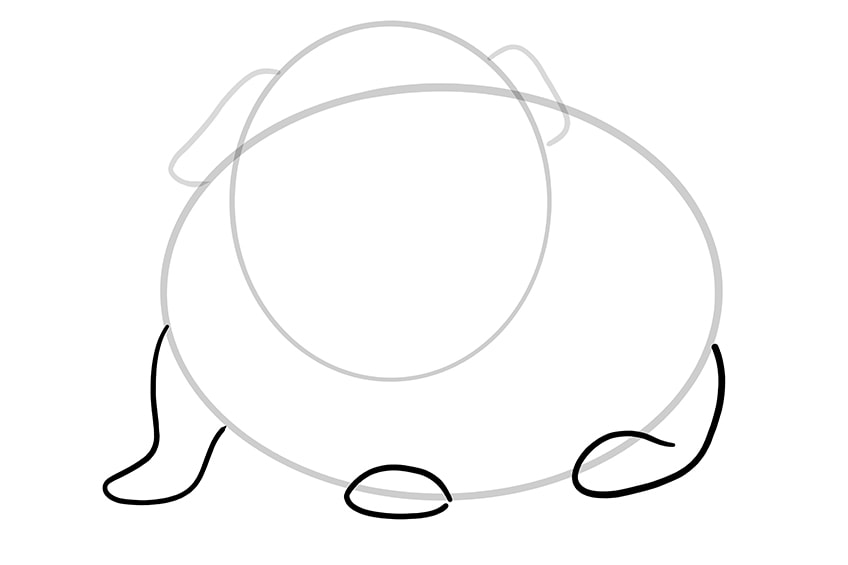
Step 5: Constructing the Face of Your Guinea Pig Sketch
In this tutorial, we are drawing the guinea pig’s whole face, but it is at a slight angle. In order to get all of the facial features the right size and in the right place, we are going to begin by using some construction lines to plan out the face.
Begin by drawing a single vertical line through the guinea pig’s head. This line should cross through the central point of both the top and bottom of the head oval, but it should curve to the right. Next, draw a horizontal line that begins low and curves up just below the bottom of both ears. Draw another two curved horizontal lines towards the bottom of the head construction oval.
These bottom two lines should be closer together, as these are going to help you draw the nose and mouth in the next few steps.

Step 6: Drawing the Final Outline of the Guinea Pig’s Head
It is time to begin using all the construction lines that you have drawn to create the final outline of your guinea pig sketch. Although you are creating the final outline, this should not be a single line. Instead, use short strokes to outline the head, giving the impression of fur. Begin at the center of the head and make sure that the fur strokes flow outwards away from this center line on both sides. You can use single smooth lines to outline the ears, adding a little fold in each.
You will see in our example below that we have not stuck closely to the construction oval. Do not be afraid to add lumps and bumps to make your drawing more natural and realistic.
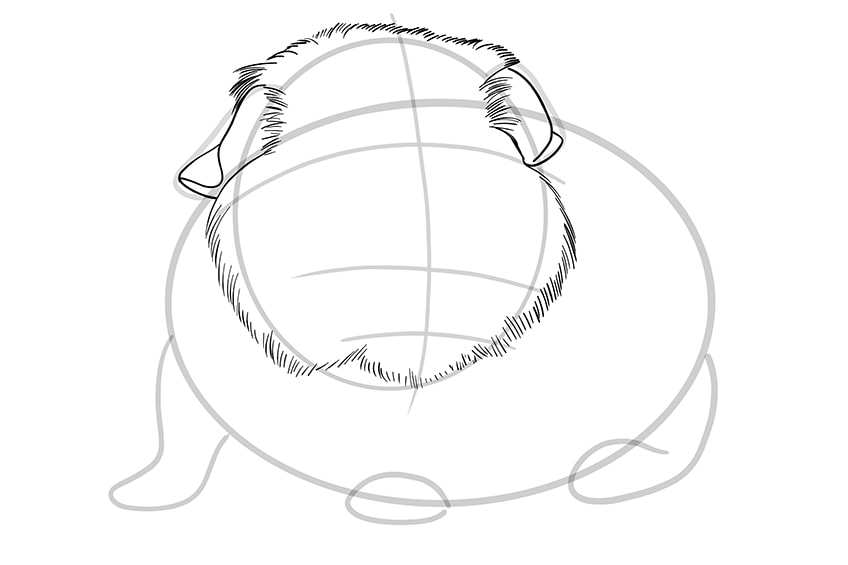
Step 7: Drawing the Final Outline of the Guinea Pig’s Body
In much the same way that we outlined the head in the last step, use short hair-like strokes to outline the rest of the guinea pig’s body. The only smooth areas should be the feet, where you can add in some toe decoration.
For the greatest sense of realism, use the curvature of the guinea pig’s body to help you draw the hairlines in the right direction. For example, you want the fur to flow outwards and down the guinea pig’s back.
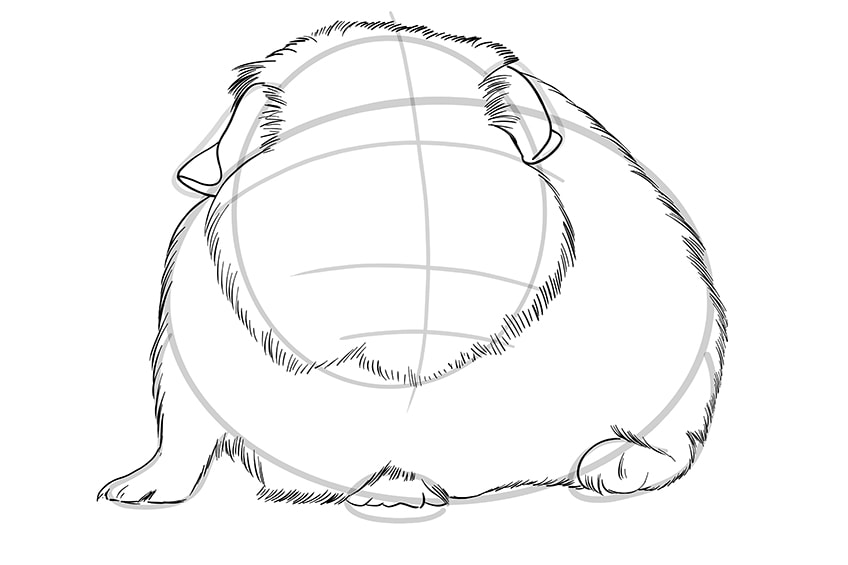
Step 8: Drawing the Guinea Pig’s Facial Features
In this step, you are going to use the construction lines in the face to add the facial details. You are going to use these lines to help you draw the eyes, nose, and mouth.
Begin by using the top construction line as the center point for the two eyes. Use an oval shape that slants to the right to create the left eye and a half circle for the right eye. Add some fur strokes around these eyes and a few additional rings to add depth.
Remember to leave a small blank space in each eye to represent the reflection in the iris.
For the nostrils, use the middle horizontal construction line as your basis, and add one nostril on either side of the central construction line. Add a little line of fur details above the nostrils, and you can add whiskers all around the nose. Finally, use the bottom horizontal line to draw three curved lines to create the mouth. Add a little chin line below the mouth too.
When you are happy with your face details, you can erase any remaining construction lines.

Step 9: Drawing Fur Throughout Your Guinea Pig’s Body
Although this step is very easy, it is also quite time-consuming. It is best not to rush the process, as the more time you take the neater the end result will be. Begin by drawing both straight and curved hairlines from around the nose. These hairs should go outwards in all directions, following the curvature of the guinea pig’s face. As you get to the guinea pig’s body, you can use slightly longer hairlines. Leave the ears, nose, mouth, and feet clear from hair.
Throughout this step, make sure that you are following the curvature of the guinea pig’s body. You can leave little gaps throughout the hair as you can see in the example below because these will help you place highlights later.

Step 10: Adding the First Coat of Color
In order to achieve realistic coloring, you need to build up the color in a few steps. In this first coloring step, use a very light shade of brown or caramel to add a base color to the entirety of your guinea pig drawing. You want this coat to be as smooth as possible.
You are, of course, welcome to make your guinea pig any color you like. Which ever color you choose to use, this first color should be very light as we are going to add darker colors in the next few steps.

Step 11: Adding Some Light Contouring
In this step, find a light black paint and use it to lightly add a touch of shading around the frame of the guinea pig’s body. Focus this shading around the guinea pig’s eyes, the bottom of the head, and around the bottom of the guinea pig’s body. Give the ears another coat of light brown.
Remember to keep this shading light, as it is difficult to remove it but always easy to add more if necessary.

Step 12: Adding the Second Coat of Color
For the second color coat, you need a vibrant white shade. You are going to add this white to the center of the guinea pig’s face, and all around its cheeks. You can also add a stripe of white down the guinea pig’s chest, and use it to highlight the lines you left in the hair detailing. .

Step 13: Adding Shading to Your Guinea Pig Sketch
In this step, you are going to use a touch of black again to retouch the contouring you did in the last shading step. Very gently, add more shading around the base of the ears, below the head, and around the feet.

Step 14: Coloring the Details in Your Guinea Pig Drawing
For this step, you are going to need a light pink shade, black, and white to color your details. Begin with a sharp brush and add a dab of your white shade to the reflection in each eye. Next, use a small brush to add your light pink to the nose and mouth area of your guinea pig drawing. You can add a second coat of this pink down the center of the nose and in the mouth, and add some black to the nostrils.
Finally, you can paint the bottom of the paws with this pink shade, blending it up into your other colors.

Step 15: Finalizing Your Guinea Pig Sketch
In this final step, you are going to trace some of your fur strokes with light grey paint to make them appear more natural. You can also remove the outline of your drawing by painting it over with the corresponding color. These last touches will elevate your guinea pig drawing, making it look more realistic and natural.
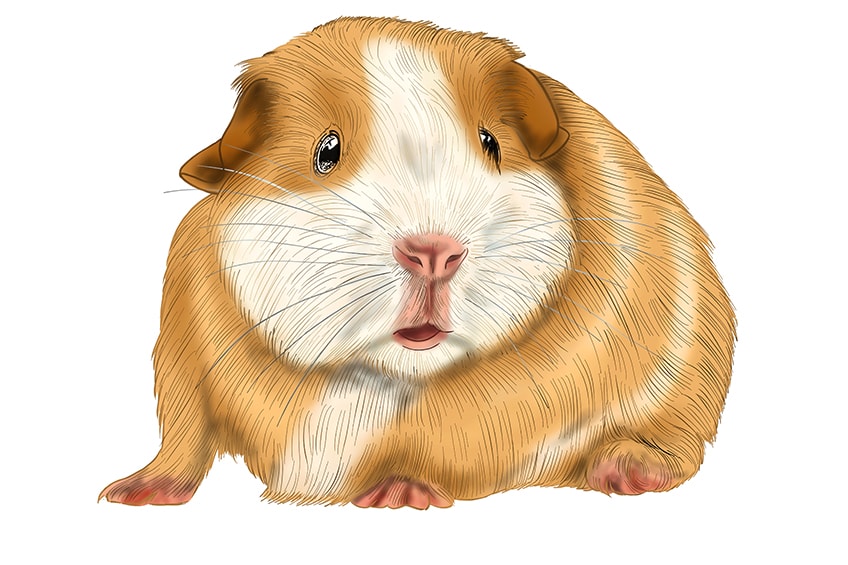
Congratulations for coming to the end of this in-depth guinea pig drawing tutorial. We hope that you have enjoyed experimenting with perspective and adding details, and that you now feel more confident planning and executing drawings of all kinds.
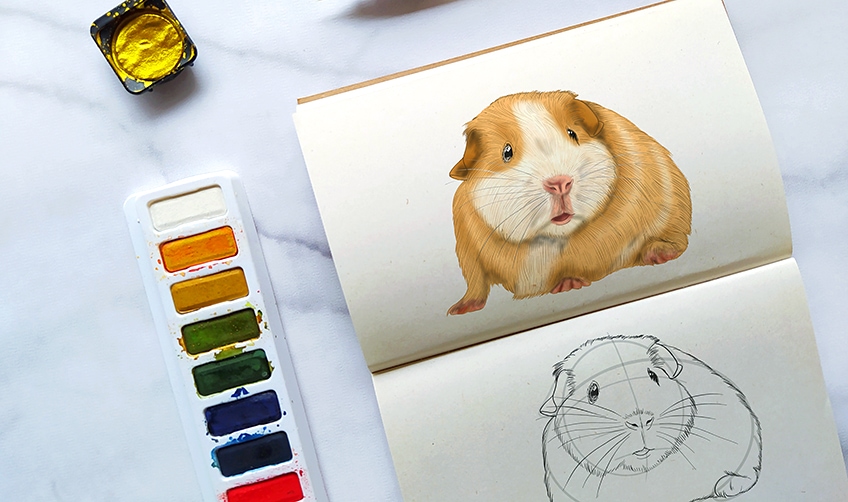
Frequently Asked Questions
Is It Difficult to Create a Guinea Pig Sketch?
Learning how to draw a guinea pig is no more difficult than drawing any other animal. In fact, thanks to their fairly simple shape, guinea pigs can make great subjects for those who are new to animal drawing.
How Can I Get the Proportions Right in My Guinea Pig Drawing?
For all of our animal drawing tutorials, we always begin by using construction lines and shapes. Construction lines are the best way to make sure that you have got the proportions and dimensions spot on before you start adding details. There is nothing worse than creating a beautifully intricate drawing of the head, and then finding that you have not left enough space for the body.
Matthew Matthysen is an educated multidisciplinary artist and illustrator. He successfully completed his art degree at the University of Witwatersrand in South Africa, majoring in art history and contemporary drawing. The focus of his thesis was to explore the philosophical implications of the macro and micro-universe on the human experience. Matthew uses diverse media, such as written and hands-on components, to explore various approaches that are on the border between philosophy and science.
Matthew organized various exhibitions before and during his years as a student and is still passionate about doing so today. He currently works as a freelance artist and writer in various fields. He also has a permanent position at a renowned online gallery (ArtGazette) where he produces various works on commission. As a freelance artist, he creates several series and successfully sells them to galleries and collectors. He loves to use his work and skills in various fields of interest.
Matthew has been creating drawing and painting tutorials since the relaunch in 2020. Through his involvement with artincontext.org, he has been able to deepen his knowledge of various painting mediums. For example, watercolor techniques, calligraphy and lately digital drawing, which is becoming more and more popular.
Learn more about Matthew Matthysen and the Art in Context Team.







